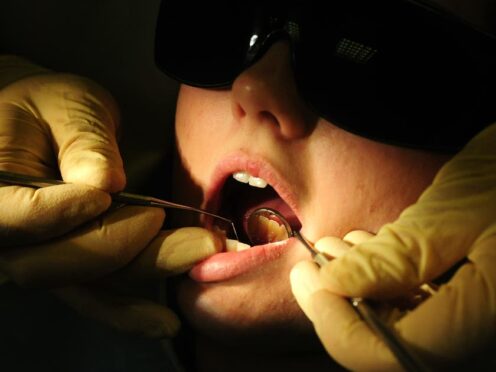It’s understandable to feel embarrassed or scared by the whole smear test process.
To help you understand more about it, we asked Robert Music, the chief executive of Jo’s Cervical Cancer Trust, to answer some common questions you may not want to ask anyone else.
1. What does a smear test look for and why is it important?
The aim of a smear test is to look for any abnormalities in the cervix and find them before they can potentially turn into cancer if left untreated.
Cervical cancer is caused in over 99% of cases by a virus called human papilloma virus (HPV). It’s a really common virus that 80% of us will have at some time in our lives.
You won’t know about it as it doesn’t have symptoms and generally our immune system will get rid of it within about 18 months or so. But for those women for whom the virus persists, there’s a risk it can turn into abnormal cells in the cervix.
I think the key thing is to remind everyone that this is a test to prevent cancer, not to find cancer.
2. How long does it take abnormalities to turn into cancer?
On average it takes about 10 years for abnormalities to turn into cancer, although is it sometimes different.
That’s why the screening of every three (for women between the ages of 25 and 49) or five (women between the ages of 50 and 64) years is deemed to be very safe, because even if you’ve got an abnormality and it happens between one screening and the next one, they are almost certainly going to be abnormal cells that are pre-cancerous.
3. What will happen at my appointment?
So you’ve received your invitation letter from your GP and booked your appointment. The whole appointment should take around 15 minutes.
The test itself may take between two and five minutes. The majority of times the test is taken by a practice nurse, who is, most of the time, a woman. You can ask beforehand to only be seen by a woman and you can take a friend or family member to support you.
The practice nurse will talk through what will happen. It is very important for the practice nurse or smear taker to communicate what’s going on and make you feel as comfortable as possible and deal with any questions you may have.
You’ll be asked to undress from the waist down. If you are wearing a skirt, you can keep it on, otherwise the smear taker will provide something to cover you up.
You will then lie on an examination bed and the smear taker will insert a plastic instrument called a speculum into your vagina.
From there, they have a specially-made brush to take a sample from the cervix. They twist the brush, take off some sample cells, which are put into a vial of liquid to preserve them, and that’s what is sent off and looked at under a microscope in a laboratory.
Once you are dressed again, the practice nurse should then explain what the next steps are, how long it will take until the results will be back, and what the results may mean.
Over nine out 10 smear tests come back absolutely fine.
4. Will it hurt?
The feedback from women I have personally spoken to and those who come to Jo’s Cervical Cancer Trust is that for the majority it doesn’t hurt. There can be a short bit of discomfort, but it is uncomfortable, rather than painful.
Certainly for some it can be very uncomfortable, but the woman should tell the smear taker if they are worried.
5. Can I get a smear test while I’m on my period?
Generally the recommendation is that it is best not to. This is because it is easier to find the cervix and take the best sample if not.
6. Can I get a smear test if I’m not registered at a doctor’s surgery?
You have to be registered at a doctor’s surgery to receive your invitation for cervical screening, so it’s really important that you are registered. Some sexual clinics do offer smear tests, however.
7. What if there is an abnormal result?
If an abnormal result is returned, you would be asked to go for a colposcopy. In effect, that’s looking at the cervix with a magnifying glass so the health professional can get a better view.
Depending on what they see, you may have to come back for a follow-up appointment or sometimes they can treat it there and then, if any treatment is required.
The aim is to remove those cells and send them off to be tested. Six months after your treatment, you will be called back for a repeat cervical screening test, where they will check to see if you have high-risk HPV.
This is called Test of Cure. If everything is fine, you’ll go back into the normal cycle of testing. However, some women may need further treatment.
8. Why is the threshold for testing 25 years old?
In terms of the starting age, it’s 25 across the UK now. This is guided by experts, who say screening women under 25 can do more harm than good.
The reason for that is that the high-risk HPV infections are far more common in women under 25. So there is the risk that if you are called into screening, there may be an abnormality that the body’s immune system would naturally get rid of in 18 months or so.
As a result you could be treating or over-treating unnecessarily, which could then potentially have an effect on the cervix. This could lead to a risk of pre-term labour later in life.
9. I’m under 25. What should I do if I’m worried?
If you have symptoms, you should go and see your GP. Depending on the symptoms, a GP should be examining women and if they see anything of concern, referring them to gynaecology.
Typical symptoms of cervical cancer are abnormal bleeding, during and after sexual intercourse or in-between periods, as well as post-menopausal bleeding and unusual vaginal discharge.
What is really important to get across is that it’s about separating screening awareness for those over 25 and eligible for a smear test and symptoms awareness for those who are under 25.
It’s about trying to get as early a diagnosis as possible, or to rule it out.
10. I’ve been a victim of sexual violence and feel worried about going for a smear test. What shall I do?
Booking and going for a smear can be a very difficult decision and maybe even harder for certain groups of women.
It’s really important for women who go for their test to have that conversation with the smear taker, if possible.
There are also specialist services available for women with experience of sexual abuse.










